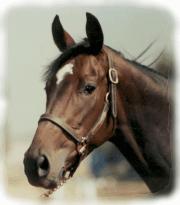A Horse, of Course with Don Blazer |
If you enjoy learning about horses, then you'll love our online courses. Each month you'll find a new column on our web site. We hope you'll enjoy it, and maybe e-mail us with questions or suggestions for other columns. A Horse, Of Course is a monthly column syndicated by Success Is Easy. If you like the column, call your local newspaper, or local horse publication and ask them to subscribe by contacting Success Is Easy. |
Open Wide Don Blazer copyright©2012 |

I don’t think the majority
of horses like the dentist any more than I do. But just the same, they need regular checkups…twice a year on young horses (which have relatively soft teeth compared to older horses) and once a year on older horses is usually pretty good. Even though they don’t brush after every meal (or floss), horses seldom have a cavity…just a few rough edges. The rough edges develop because the horse’s upper jaw is wider than the lower jaw. Therefore, the outside edge of the upper molars and the inside of the lower molars are not worn smooth during the grinding process of chewing. These sharp edges can cut the inside of the horse’s mouth or tongue and make him most uncomfortable. To smooth out the situation, someone (and here’s where we have our first controversy) will “float” the horse’s teeth. Water isn’t used to do the job—a long-handled rasp, known as a “float” is used. Some people (mostly veterinarians) say that only a licensed veterinarian should be allowed to float teeth. Others (mostly lay persons who float teeth) say anyone trained in equine dentistry should be allowed to float teeth. Frankly, you don’t have to be a genius to float a horse’s teeth…you need some equipment, some knowledge and some strength. It isn’t a particularly easy job, and a lot of veterinarians I’ve known don’t like doing it; so they don’t do it very well and they don’t suggest it be done very often. Yet, they don’t like others doing the job and earning a pretty good rate of pay per hour. I’ve known some veterinarians who do a great job of floating, and I’ve known some individuals who are excellent at floating….I’m not bad at it myself. You’ll have to make up your own decision on who you want to float your horse’s teeth…but whatever you do (and this is the second controversy) don’t allow anyone use a “power float” on your horse’s teeth. “Power floats” are just what you think…a power tool to grind down the horse’s teeth. And that is what they most often do; grind down the horse’s teeth beyond what is needed which can actually affect the horse’s healthy life span. Horses teeth are formed in what is called “continuous eruption”…they just keep growing upward (or downward). So if you grind too much off the teeth now, there is a lot less tooth left for his later years. The third controversy is the “show float” or “bit seat” where the first molar is rasped off at an angle so the bit can rest up against it. Don’t allow it to be done to your horse. No horse needs it. No one who advocates it knows how to use a bit correctly. Horse’s don’t care for floating not because it hurts (they don’t have the same type of nerve system as humans) but because they are offended by the size of the toothbrush. Horses aren’t crazy about having a tooth pulled either. Caps, which are just what is left of a baby tooth sitting on top of the permanent tooth, can be spit out by the horse, and usually are. On the other hand, if for some medical or trauma reason, a tooth must be extracted, the process is very difficult and the horse usually needs to go to an equine hospital. A foal will get his first teeth—the two middle nippers…at about two weeks of age. A mature male horse has 40 teeth while a mature mare has 36. The stallion or gelding has “tushes”, or pointed teeth between the incisors and molars. Tushes are not always found in mares. Sometimes horses will develop small, pointed teeth in front of and right up against the molars. These teeth are known as “wolf” teeth. They don’t often appear in the lower jaw, but the can. A lot of people recommend having the wolf teeth removed, claiming they bother a horse when he is carrying a bit. If that’s the case, then the person using the bit has it misplaced, or is using it incorrectly. The bit shouldn’t be hitting the teeth. Usually horses don’t have crooked teeth. On occasion, however, they’ll have teeth that don’t meet properly. If the upper teeth stick out in front of the lower incisors, this is called “parrot-mouthed.” When the lower teeth are in front of the uppers, then it is called an “undershot jaw.” Both conditions are considered genetic defects, and horses with either condition should not be bred. Today, such conditions are not as serious as when virtually all horses grazed and had to bite off growing feed. |